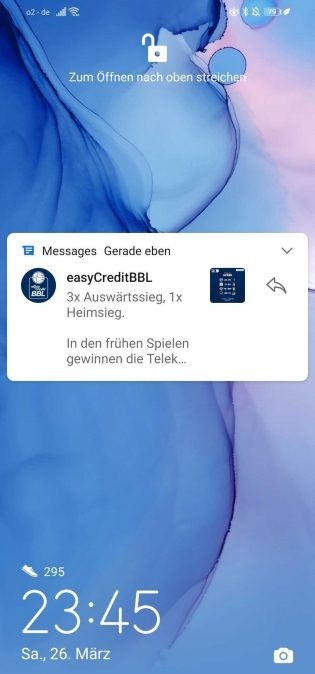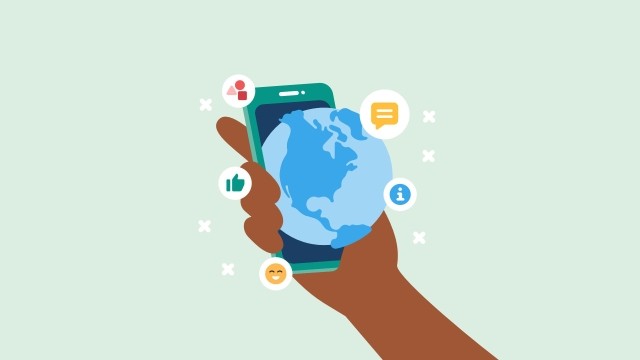SMS for customer communication? Practical, for sure. But also boring. Old-timey. One-dimensional. That's how a lot of companies feel about using SMS. And they were right, until very recently, that is. Now, the good old SMS got an update: RCS messaging. And it opens up a whole new world of possibilities. We explain, what RCS messaging is, how it compares to other messaging apps, and how powerful it can be for connecting with customers.
With all this buzz around messenger applications, such as WhatsApp, the Messenger from Meta or WeChat, it seems that internet-based OTT messaging (over-the-top messaging) is replacing the SMS. This could not be further from the truth. In fact, the good old SMS is shaping out to be a powerful tool for businesses to connect with their customers.
And the main reason for that is a recent upgrade to text messaging: RCS messaging. RCS messaging now offers businesses a lot of amazing opportunities to reach their clients directly, with engaging content, on a channel they won't ignore.
What is RCS messaging?
RCS messaging stands for rich communication services. It's a re-booted SMS protocol that basically takes text messaging to the next level. It allows rich features, such as:
- high-definition images
- videos
- linked buttons
- maps
- QR codes

RCS messaging takes the plain text message, and turns it into an immersive and engaging communication experience. This is why many experts are calling RCS messaging the future generation of messaging. In a recent market study, Juniper Research even predicted that 2022 would be the crucial year for RCS. According to their data, the number of RCS subscribers is expected to grow from currently 1.2 billion to 3.8 billion by 2026; accounting for 40% of global mobile subscribers.
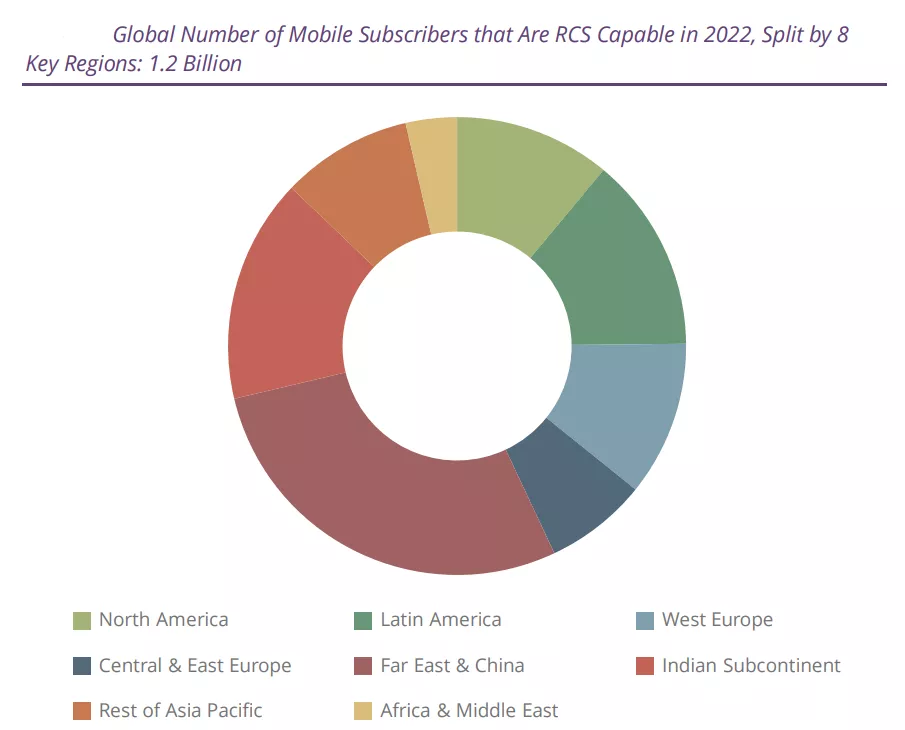
by 2026. (Source: Juniper Research)
Why is that important? Because it makes text messaging, already a widely used communication channel around the world, even more relevant.
The power of SMS
The SMS might have been around for many years, but that doesn't mean that people aren't using it anymore. In fact, people love sending text messages. They are short, to the point, and reach the other person directly. Text messages are also more flexible than a phone call because you don't have to answer right away. Instead, you can get back to the other person whenever it is most convenient to you.
As a result, as of 2007, people were already sending more text messages than phone calls. People text their family, their friends or their co-workers. However, also businesses increasingly use SMS for customer support, to ask for feedback or send rewards. Altogether, 15 million texts are being sent every minute — a whooping 22 billion SMS messages per day.
And: according to research from Dynmark, People read their text messages, and respond!
- SMS has an open rate of 98%.
- 90% of texts are read within 3 seconds.
- Nearly a third (29%) of SMS marketing recipients click on links in messages they receive.
That's just with the regular SMS capabilities. Imagine adding to that the possibilities that RCS messaging brings! It's not hard to see why RCS is predicted to be such a powerhouse in connecting with your customers. So, what exactly is the difference between SMS and RCS?
SMS, MMS, RCS: What's the difference?
It's easiest to understand the difference between RCS and SMS if we look at MMS (Multi Messaging Service) first.
MMS was the first step in making it possible to send rich content like pictures, videos. RCS is the next level of multimedia messaging. It manages sending multimedia content in a much more interactive and engaging way.
RCS messages work with other elements of a smartphone, like a web browser, maps, and other apps, meeting user demands for a better and more seamless user experience.
How's the reach of RCS messaging?
To date, more than 360 million smartphones are active with RCS worldwide. However, the rollout process is not universal.
It has become apparent that the rollout of RCS messaging depends very much on the market, as different local operators control the SMS / RCS market in each country. So, there are some significant regional differences.
In China, for example, RCS is included as part of the 5G rollout. In the US, carriers are working with different phone manufacturers, such as Google or Samsung, to connect their customers' phones to the RCS protocol.
In Germany, operators Deutsche Telekom, Vodafone and O2 have introduced RCS. According to their data, currently 70% of German Android phones are RCS ready.
Keep in mind though that Apple doesn't support RCS on iOS, at least for now. Businesses that want to reach their Apple customers have to use Apple Messages for Business. In some countries, such as Germany, it's possible though to use an RCS software solution to send newsletters to customers on both, Apple and Android devices.
How does RCS messaging compare to OTT messaging?
In a way, OTT messaging services like WhatsApp, the Messenger from Meta or Instagram Direct have been offering a rich messaging experience for users for years. Since they have opened up their messaging apps towards a business use, the market has grown at a steady pace. Overall, messaging and chat apps are the most-used internet services around the world, according to data from Hootsuite, and We are Social.
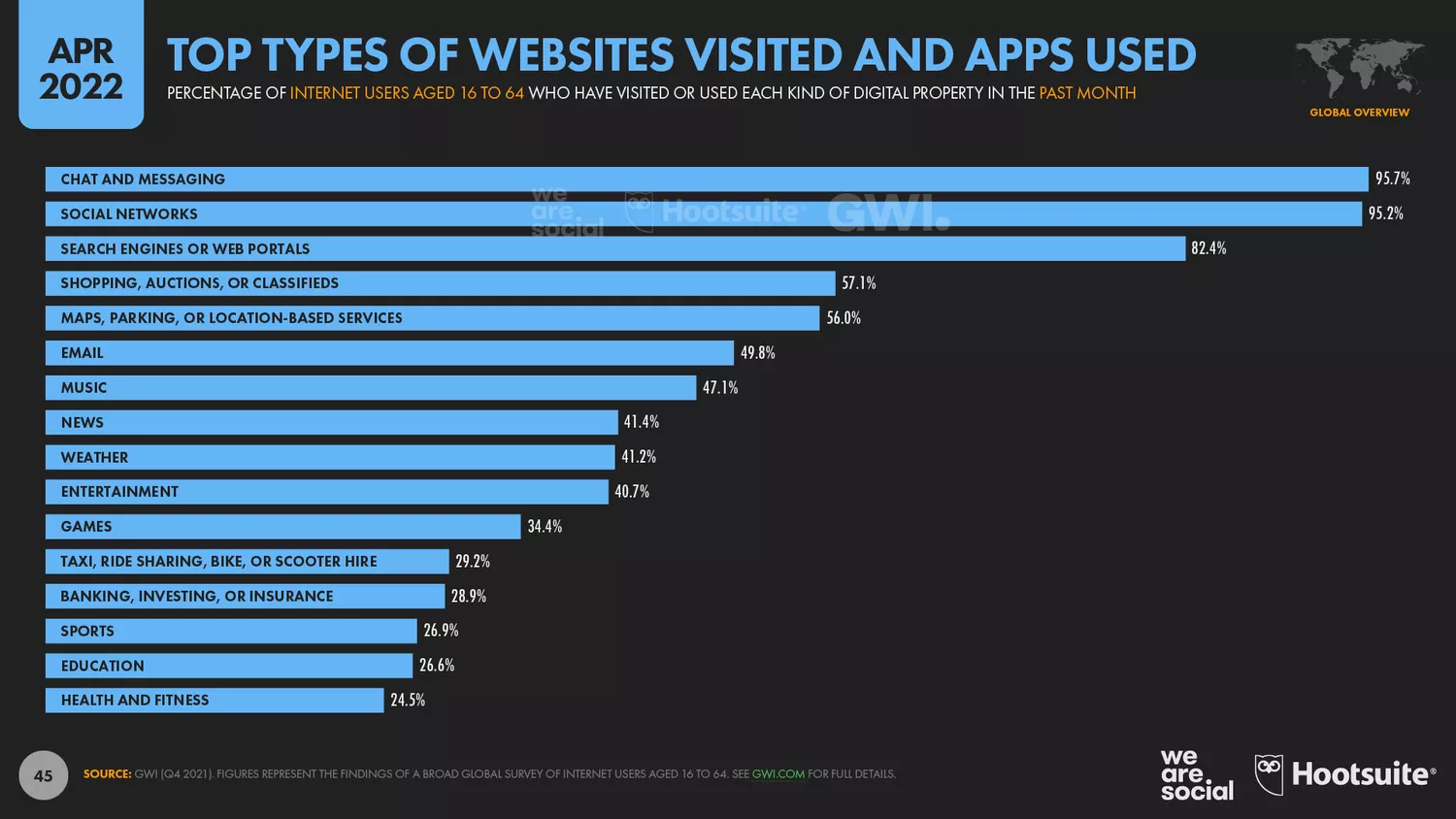
The potentials of messaging apps for companies are huge, especially in markets such as India or Brazil where virtually everybody uses WhatsApp, and even prefers talking to businesses on the app, as opposed to text messaging.
There's also the question of end-to-end encryption, which is a given with most messaging apps, whereas it was only recently introduced to RCS messaging. Google added end-to-end encryption to chat-based conversations in Google Messages in 2021, yet the feature is, so far, only available for one-on-one conversations, and not for group chats, which is why some companies (and users) prefer OTT messaging.
However, even though OTT messaging is a growing market, compared to the SMS market it's still relatively small. The reason is simple. In order to use OTT messaging, users need to download an app, whereas basically every phone has SMS capabilities.
That makes access to customers a lot easier, and is the reason why, in many markets, businesses still prefer SMS messaging. With RCS now finally taking off, the SMS market for businesses will likely grow.
In addition to RCS messaging, there is also another trend that is pushing the growth of texts: two-factor authentication, or 2FA.
The relevance of 2FA for RCS messaging
Technically, 2FA is a regular SMS that customers receive to verify their online banking transactions ("mobile TAN"). As this has become a legal requirement in some regions, such as the European Union, the number of sent SMS has been going up. Even in countries like Germany, where the number of SMS messages has been decreasing since 2012, due to 2FA, it's now going back up.
This doesn't automatically affect RCS messaging, but it could have an effect on user behavior. If customers are getting more used to dealing with businesses through SMS, it could open the doors for other text message based business uses, such as customer service, conversational marketing or consultations via RCS messaging.
How companies can use RCS messaging to their advantage
Even though there are regional differences in RCS rollout, and Apple still doesn't support the messaging protocol, there are still a lot of reasons for companies to use RCS messaging to communicate with their customers.
- Compared to SMS, conversion rates double with RCS, as the messages are so much more engaging, and you are able to send links.
- Your messages will end up front and center on the users' phones, without them having to download an app. In other words, RCS and SMS give you access to your customers' most direct communication channel.
- In the US (and soon, probably also in other countries), there is a directory for registered companies. Only verified companies are allowed into the directory, which already sets you up as a trustworthy business. Furthermore, starting early with RCS messaging also allows you to build brand recognition and establish customer loyalty early.
The fact that the RCS protocol is able to communicate directly with other apps on a user's phone, such as maps or videos, makes it possible for you to send your customers high-quality content that is displayed directly in their messaging windows. This opens up many possibilities for customer communication.
Improve the customer experience, drive conversions
From a user's perspective, receiving rich communication messages is a lot more engaging. The fact that you can add videos or images to the text message enables customers to experience one seamlessly integrated process in one window. There is no need to switch to a different app.
This rich, frictionless user experience drives conversions. For instance, just adding a video to your message can increase conversions by 86%.
But there's more!
Data shows that rich messaging content drastically improves the first impression potential customers have from a company. RCS messaging can lead to:
- 75% form completion rate
- 12% conversion rate on first purchase
Even after the initial contact, RCS messaging can enrich the customer experience throughout the entire customer journey. Combining RCS with personalized messaging results in:
- 220% ROI
- three times higher conversion rate (compared to e-mail)
RCS messaging is also very effective when it comes to re-kindling the relationships with your customers. It leads to a:
- 50% lower churn rate
This shows how RCS can boost the customer experience (and your returns) significantly.
🛍️ Beyond RCS: Find out how retail companies can improve customer experience with messaging apps!
Cut operations costs
Companies whose businesses involve operations, such as delivery or pick-up services, often deal with high costs due to no-shows. These costs can be cut by RCS messaging. For instance, by including a map in the pick-up notifications for customers, companies can make sure that fewer customers will not show up because they didn't find the pick-up location.
If customers are meant to pick up an item from a lockbox, for instance, no-shows can be reduced by including a video in the pick-up message that explains how to open it. Overall, with RCS messaging, companies can save:
- 20% reduction in no shows
- 35% decrease in non-pickups
RCS can therefore be a huge cost saver!
Reach customers directly
RCS will take your message directly to the customers. This doesn't only mean that your messages will be seen, it also opens up the possibility for one-on-one conversations with your customers--which is exactly the type of conversations customers are expecting from brands these days.
Today, 90% of customers would love to be able to reply in-message to ask questions; and today, 89% of consumers say they want two-way conversations via messaging channels and apps. They want rich experiences that give them the power to take action.
What many businesses might not know: It's also possible to send out marketing messages through SMS or RCS to your customers. They end up on your customer's locked screen as a push notification, and are great engagement drivers as well as a great possibility for customer retention.
These companies are incredibly successful with RCS
Some companies have already started using RCS messaging successfully, and it shows the variety of use cases and benefits it can have for businesses.
Nissan: Improving customer relations
The Japanese car brand Nissan knows that in the automotive sector, a customer life cycle is long. As a result, the Japanese company has recognized the importance of their local dealerships to communicate with the customers directly to build trust. However, a few years ago, Nissan had noted that the customers' response rates to traditional communication channels had gone down.
In search for more engaging alternatives, Nissan Europe launched a mobile messaging strategy. Using RCS messaging, Nissan's local dealerships in Spain promoted the new Nissan MICRA to customers through the Rich format.
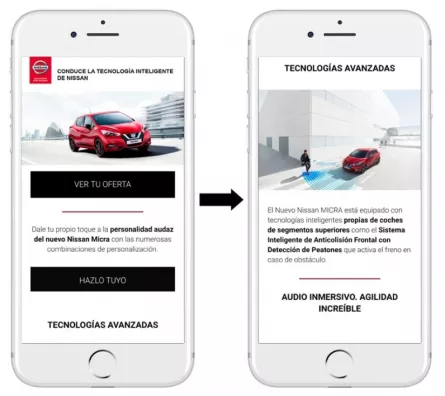
The format was so successful that Nissan decided to use the Rich SMS format for three new types of campaigns.
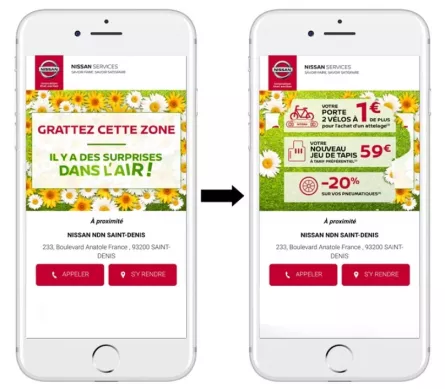
In six months, 200,000 customers received these SMS messages from their dealership.
Nationwide: Combining speed of SMS with details of e-mail
For the British financial institution, Nationwide Building Society, direct communication with their customers is key. As the company was looking for new and innovative ways to stay in touch with their members, the Covid-19 pandemic hit—and affected millions of people economically.
Nationwide started a payment holiday program to help their members with mortgage payments and loans. As they needed a quick and engaging way to explain the program to their members, they decided to use RCS messaging.
We needed the pace of SMS, but the detail of email. And what better way to give a full-but-instant message than with Rich SMS?
Simon Dixon, Demand Manager in Communication Delivery & Logistics at Nationwide
The same speed and accuracy was needed after the program was ended, to explain members the next steps. And again, Nationwide chose to send out an RCS campaign to their members. The success was unprecedented.
In the banking sector, text message campaigns generally have a unique click-through rate (CTR) of about 10%, and an engagement rate of 22%. Nationwide’s campaign had a CTR of 47.6% and an engagement rate of 90.7%.
Not only did we have a strong member response, but we also had quite a strong internal response as well. The overwhelmingly positive response has helped us build trust internally and externally.
Simon Dixon, Demand Manager in Communication Delivery & Logistics at Nationwide
easyCredit BBL drives engagement with RCS newsletter
The German basketball league, easyCredit BBL, sends out a regular RCS newsletter to keep their subscribers informed about the latest basketball news.
Using a professional software solution from Sinch Engage, easyCredit BBL is able to reach Android and iOS phones across Germany. Users first get a push notification on their locked screen that they can't miss.
Once they open the message, they're able to read interesting content about the latest basketball developments in the country, which makes for a highly engaging user experience.
The key to success with Rich SMS
While the results of these Rich SMS campaigns are impressive, companies need to be aware of one important factor before rolling out a campaign: in many markets, not all carriers support RCS yet, which means that your RCS messages won't reach every user.
That's where professional solutions like the Rich SMS Software by Sinch come in. The Rich SMS Software by Sinch uses a special software that makes it possible to reach all users with your messages. It's actually very easy to start personalized Rich Messaging campaigns right away (no technical skills needed).


